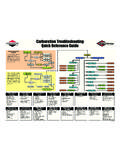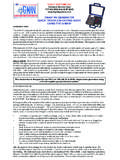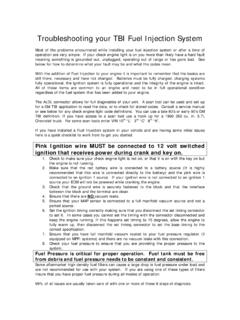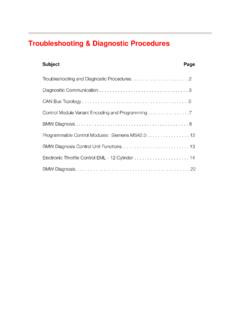Transcription of Diesel: Troubleshooting - Diesel Fuel Injection Sales ...
1 Diesel : Troubleshooting Probable Cause engine Hard to Runs Lack of Diesel Black White Blue not start rough at power knock / smoke smoke smoke starting engine lower pinking RPM. Low compression X X X. Low fuel pressure X X X X X X. Low cranking speed flat X X. battery Glow plugs or X X X. relay faulty Insufficient fuel X X X X X. supply Fuel Quality . petrol - X X X X X X. contamination Air vacuum in X X X X. fuel supply Blocked fuel X X X X X. supply - filters Faulty Diesel X X X X X X X. injector/s Faulty high X X X X X. pressure pump Faulty pressure regulator - X X X X. sensor Faulty low pressure supply X X X X. pump Air intake X X X. restriction Turbo problems . X X X X. waste gate EGR problems X X X.
2 Injector blow-by X X X X. seat leaking Cam crank X X X X X X. sensor Injector wiring X X X X. harness Internal engine X X X X X. problems Low compression Low engine compression will result in insufficient heat being generated to ignite the fuel and cause hard starting. This is more of a problem with older or high mileage vehicles. To find out the compression perform a cold engine compression test. Compression should be between 20 to 35 bars or 300 to 500 PSI. Anything below this will cause starting problems. Low fuel pressure It is in this area that most fuel supply problems occur. The problem could either be poor fuel supply to the rail/injectors or the rail/injectors are not holding the fuel within the system.
3 The best way to diagnose this is to look at the fuel supply in 3 areas. 1. Low pressure supply from the tank to the high pressure pump (HPP) - some vehicles rely on the HPP to suck the fuel from the tank whilst others have an electric pump in the tank or fuel line to supply fuel to the to the HPP. The supply from the tank to the HPP should be about 2 to 5 bars. 2. Fuel is delivered from the HPP to the rail/injectors at about 200 bars during cranking, 300 bars at idle and anything from 1200 to 1800 bars running. 3. Once the fuel is delivered into the rail/injectors at the relevant pressure it must be maintained within the injectors or rail. Low cranking speed If the engine turns over too slowly, the pump cannot generate enough fuel pressure to activate start of Injection causing hard starting problems.
4 This is usually seen more in the colder months especially if the battery is run down. Glow plugs or relay faulty The engine relies on the glow plugs to generate heat to help with the combustion cycle. Some engines only use the glow plugs when cold but others will allow the glow plugs to work when the ECU. (vehicle's computer) needs them to be on to help with combustion. Problems in this area will cause Diesel engine starting problems, uneven running and white smoke when the engine is cold. Insufficient fuel supply This speaks for itself, not enough fuel in the tank or a problem with supply pipes being cracked or bent. The fuel tank breather can sometimes be blocked causing a vacuum in the tank which in turn draws the fuel back to the tank.
5 Fuel quality contamination I have been involved with Diesel fuel Injection all my working life and still find the topic of fuel and solutions controversial. Working with Diesel injectors we see the result of poor fuel quality - damage and condition of the internal components. I know that if a good quality Diesel and an solution is used regularly it will prolong the life of Diesel Injection equipment. Poor fuel quality and general wear and tear are not the only cause of injector failure, the newer type of injectors sometimes fail due to design problems. I would estimate that about 85% of injectors fail due to fuel related issues and the balance due to design problems. Air - Vacuum in fuel supply and Blocked fuel supply This is similar to insufficient fuel supply, but dirty fuel filters or a faulty filter head assembly may also cause fuel supply issues and hard starting.
6 Faulty injector/s Probably the biggest result of injector failure is due to the injectors having excessive return flow or back leakage. This is due to worn parts which allow excessive fuel to go through the Diesel injector and to return back to the tank or fuel system. This causes a drop in rail pressure (see "low fuel pressure") which results in hard starting or not starting at all. Another problem resulting from worn parts is a delay in the start of Injection which in turn results in rough running at low RPM or your Diesel not starting. Faulty high pressure pump If the pump is faulty there will be a low fuel pressure problem. This problem arises if the pump "breaks up" internally causing swarf and iron filings to get into the fuel system.
7 Normally this causes damage to the Diesel injectors and unless the complete fuel system is attended to the problem will arise again. This is an expensive failure and no short cuts can be taken. Faulty pressure regulator sensor Most vehicles have a pressure regulator fitted on the high pressure pump and a sensor fitted on the rail. If either of these are faulty there will be running issues like hard starting, uneven tick over and the vehicle cutting out when the RPM is increased. Faulty low pressure pump Not all vehicles have a low pressure supply pump but if they do it can be found either in the tank or on the fuel pipe near the tank. If your low pressure pump is faulty, you may experience symptoms similar to those of a faulty high pressure pump.
8 Air intake restriction This would be due to a dirty air cleaner, blocked pipes or a stuck butterfly valve found on some vehicles. In addition, a faulty air flow sensor on the air intake will cause problems running and excessive smoke. Turbo problems We are seeing more turbochargers failing with newer vehicles, I put it down to a combination of things, high revving engines demanding more power, incorrect driver actions(not allowing the engine to idle a while when started and before switching off), poor maintenance and not replacing old oil with a good quality oil. A turbo spins at about 42000 revolutions per minute, the average washing machine at 1000 rpm. As vehicles get older the turbo waste gate sticks causing the vehicle to either shut down, go into limp home mode or smoke excessively.
9 If a vehicle has a variable vane turbo, problems can arise if the vans carbon up, the symptoms are lack of power, black smoke and hesitation on acceleration. Also make sure that all the vacuum pipes and sensors that operate the turbo are operating correctly. Another problem is if the air pipes to and from the inlet, inter cooler and turbo leak due to damage or loose clamps , the vehicle can experience similar problems. EGR problems I do not know why EGR (exhaust gas recycling) valves were ever put onto Diesel engines, they cause more trouble than they are worth. The idea is that whilst the engine is at tick over, a valve opens and allows some of the exhaust gases to pass back into the nice clean air intake manifold.
10 After a while the gases containing dirty, sooty carbons start to cover and coat the intake area and valves causing the air to fuel ratio to become unbalanced thus resulting in more black smoke being emitted from the exhaust. This black smoke is then drawn back into the air intake via the EGR valve. A vicious cycle then starts with the engine producing more smoke and sootier carbons being drawn into the intake, a major problem. I would always recommend the EGR valve to be blanked off but some vehicles will not allow this. Injector blow by, seat leaking Injector "blow-by" can be the cause of some of the following symptoms. Hard or difficult starting /. erratic or uneven tick over or idle / lumpy running / smoke on tick over or acceleration / black tar around the injectors and a chuffing sound from the engine when running.








